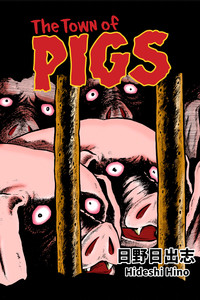Review
by Lynzee Loveridge,Town of Pigs
GN
| Synopsis: |  |
||
One night, under a blood red moon glimmering with demonic beauty, a group of devilish creatures armed with axes and spears came riding into a quiet city on horseback. One by one, they loaded the villagers up into cages and carried them off without any explanation... Kenichi barely managed to escape alive. Translation is by Dan Luffey. |
|||
| Review: | |||
Spoiler warning: for the sake of discussing the context of this manga, the end twist is included in this review. The Town of Pigs marks a long-deserved return of Hideshi Hino, a central horror manga artist whose work hasn't been released stateside in over a decade. Junji Ito has received considerably more mainstream attention in recent years and we can in part thank that success for reigniting western publishers' interest in horror manga. We're finally getting some of Kazuo Umezz's work with the new Orochi releases, but unlike Umezz and Ito's art which is more aesthetically palatable, I'm happy to report that Hino's work is weird looking. Hino cut his teeth in Garo, an underground manga magazine that is synonymous with experimentation. Unlike most mainstream artists of the period, Hino's characters are unabashedly ugly. Kenichi's large globular eyes are offset and his dark slick hair invokes comparisons to Peter Lorre. He navigates city ruins that look like they were drawn with excess of black ink swathed across the page with a calligraphy brush. His pursuers are armored men on horseback that are referred to as demons, not because of their appearance but because of their vicious cruelty. While there is a cartoonish underpinning to The Town of Pigs' art, it doesn't shy away from putting the invaders' brutality on display. They decapitate women and children, display flayed pigs' carcasses to send a message to any would-be slackers and in general revel in their destruction. Make no mistake, this may be sold as a manga about demons turning humans into pigs, but the allegory here is clear a day. This is war. The Town of Pigs is a quick read, maybe 20-30 minutes, with minimal dialogue and a thread-bare story. A boy, Kenichi, manages to escape the invading "demons" that arrive in the light of full moon. His family, neighbors, and the rest of the town are rounded up and put into train cars to be taken to prison camps. While there, they are fed slop that gradually transforms them into pigs to be sacrificed for manual labor, all in pursuit of building a giant effigy that bares at least some resemblance to The Exorcist's Pazuzu. Kenichi makes various attempts to escape the decimated city's borders all for naught, only to discover he has more in common with his oppressors than he thought. After wrapping up the volume, readers will likely find themselves at a loss. This is an allegory but unfortunately Star Fruit Books' release lacks a forward, author biography, or any other context that might help English readers full appreciate Hino's story. The closing pages has Kenichi spiraling after the reveal that the demons all share his face. He thinks that it all makes so much sense now. However, the reason it makes sense isn't revealed to the reader. It wasn't until I looked up cursory information about Hino's life that this Twilight Zone-style twist made any sense outside of trying to surprise the reader. Initially, it seemed like Hino was plumbing World War II imagery for The Town of Pigs and I assumed the demons could very well be stand-ins for American occupying forces. Until the twist, of course. It turns out that Hino has some very personal experience with Japanese imperialism, and, well, pigs. I would have loved for this release to include a small biography of Hino in the afterward, not only for the sake of contextualizing the story but also to make it a more thorough release of an author's work who has been neglected for so long. Some additional information about the importance of Garo and its place in the manga landscape would have been appreciated as well. However, this release isn't without its perks. Star Fruit Books' released utilized white instead of creme paper along with digital instead of offset printing. The result is art with a glossier finish and richer blacks than what is typical for manga releases. Overall it has a little bit more weight to it for what is otherwise a smaller page count. I'm overjoyed that we're starting to get more variety in the horror manga space and while I wouldn't consider this a "definitive release," I hope Star Fruit and other publishers start exploring older works from Garo's library and similar magazines. There's a wealth of shojo horror and experimental styles to explore and my shelf is waiting. |
| Grade: | |||
|
Overall : B
Story : B
Art : A
+ Unapologetically weird art, glossy paper, rich artwork |
|||
|
this article has been modified since it was originally posted; see change history |
|||
| Production Info: | ||
|
Full encyclopedia details about |
||